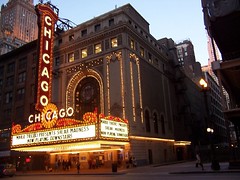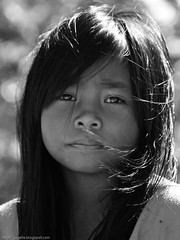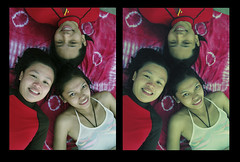by
Derrick Story, author of
Digital Photography Pocket Guide, 3rd EditionYou've heard this before: Digital cameras do all the work. You just push the button and great pictures magically appear. The better the camera, the better the photos. Isn't that right? Heck no!
The truth is that you can make great photos with a simple consumer point-and-shoot camera, or take lousy shots with the most expensive Nikon. It's not the camera that makes beautiful images; it's the photographer. With a little knowledge and a willingness to make an adjustment here and there, you can squeeze big time photos out of the smallest digicam.
To help you down the road to great image making, here are ten tips that will enable you shoot like a pro (without maxing out your credit card on all that expensive equipment).
1. Warm Up Those Tones
Have you ever noticed that your shots sometimes have a cool, clammy feel to them? If so, you're not alone. The default white balance setting for digital cameras is auto, which is fine for most snapshots, but tends to be a bit on the "cool" side.
When shooting outdoor portraits and sunny landscapes, try changing your white balance setting from auto to cloudy. That's right, cloudy. Why? This adjustment is like putting a mild warming filter on your camera. It increases the reds and yellows resulting in richer, warmer pictures.
If you don't believe me, then do a test. Take a few outdoor shots with the white balance on auto, then take the same picture again with the setting on cloudy. Upload the images to your computer and look at them side by side. My guess is that you'll like the warmer image better.
2: Sunglasses Polarizer
If you really want to add some punch to your images, then get your hands on a polarizing filter. A polarizer is the one filter every photographer should have handy for landscapes and general outdoor shooting. By reducing glare and unwanted reflections, polarized shots have richer, more saturated colors, especially in the sky.
What's that you say? Your digital camera can't accommodate filters. Don't despair. I've been using this trick for years with my point-and-shoot cameras. If you have a pair of quality sunglasses, then simply take them off and use them as your polarizing filter. Place the glasses as close to the camera lens as possible, then check their position in the LCD viewfinder to make sure you don't have the rims in the shot.
For the best effect, position yourself so the sun is over either your right or left shoulder. The polarizing effect is strongest when the light source is at a 90-degree angle from the subject.
3. Outdoor Portraits That Shine
One of the great hidden features on digital cameras is the fill flash or flash on mode. By taking control of the flash so it goes on when you want it to, not when the camera deems it appropriate, you've just taken an important step toward capturing great outdoor portraits.
In flash on mode, the camera exposes for the background first, then adds just enough flash to illuminate your portrait subject. The result is a professional looking picture where everything in the composition looks good. Wedding photographers have been using this technique for years.
After you get the hang of using the flash outdoors, try a couple variations on this theme by positioning the subject so the sun illuminates the hair from the side or the back, often referred to as rim lighting. Another good technique is to put the model in the shade under a tree, then use the flash to illuminate the subject. This keeps the model comfortable and cool with no squinty eyes from the harsh sun, and this often results in a more relaxed looking portrait.
Remember, though, that most built-in camera flashes only have a range of 10 feet (or even less!), so make sure you don't stand too far away when using fill flash outdoors.
4. Macro Mode MadnessRemember as a kid discovering the whole new world beneath your feet while playing on the grass? When you got very close to the ground, you could see an entire community of creatures that you never knew existed.
These days, you might not want to lie on your belly in the backyard, but if you activate the close up mode on your digital camera and begin to explore your world in finer detail, you'll be rewarded with fresh new images unlike anything you've ever shot before.
Even the simplest object takes on new fascination in macro mode. And the best part is that it's so easy to do with digital cameras.
Just look for the close up or macro mode icon, which is usually a flower symbol, turn it on, and get as close to an object as your camera will allow. Once you've found something to your liking, hold the shutter button down halfway to allow the camera to focus. When the confirmation light gives you the go ahead, press the shutter down the rest of the way to record the image.
Keep in mind that you have very shallow depth of field when using the close up mode, so focus on the part of the subject that's most important to you, and let the rest of the image go soft.
5. Horizon Line Mayhem
For some mysterious reason, most human beings have a hard time holding the camera level when using the LCD monitors on their digicams. The result can be cockeyed sunsets, lopsided landscapes, and tilted towers.
Part of the problem is that your camera's optics introduce distortion when rendering broad panoramas on tiny, two-inch screens. Those trees may be standing straight when you look at them with the naked eye, but they seem to be bowing inward on your camera's monitor. No wonder photographers become disoriented when lining up their shots.
What can you do? Well, there's no silver bullet to solve all of your horizon line problems, but you can make improvements by keeping a few things in mind.
First of all, be aware that it's important to capture your images as level as possible. If you're having difficulty framing the scene to your liking, then take your best shot at a straight picture, reposition the camera slightly, take another picture, and then maybe one more with another adjustment. Chances are very good that one of the images will "feel right" when you review them on the computer. Simply discard the others once you find the perfectly aligned image.
If you practice level framing of your shots, over time the process will become more natural, and your percentage of level horizon lines will increase dramatically.
6: Massive Media CardWhen you're figuring out the budget for your next digital camera, make sure you factor in the purchase of an additional memory card. Why? Because the cards included with your new high-tech wonder toy are about as satisfying as an airline bag of peanuts when you're dying of hunger.
If you have a 3 megapixel camera, get at least a 256MB card, 512MBs for 4 megapixel models, and 1GB for for 6 megapixels and up.
That way you'll never miss another shot because your memory card is full.
7: High Rez All the Way
One of the most important reasons for packing a massive memory card is to enable you to shoot at your camera's highest resolution. If you paid a premium price for a 6 megapixel digicam, then get your money's worth and shoot at 6 megapixels. And while you're at it, shoot at your camera's highest quality compression setting too.
Why not squeeze more images on your memory card by shooting a lower resolution and low quality compression settings? Because you never know when you're going to capture the next great image of the 21st century. And if you take a beautiful picture at the low 640 x 480 resolution, that means you can only make a print about the size of a credit card, not exactly the right dimensions for hanging in the museum.
On the other hand, if you recorded the image at 2272 x 1704 (4 megapixels) or larger, then you can make a lovely 8- x 10-inch photo-quality print suitable for framing or even for gracing the cover of Time magazine. And just in case you were able to get as close to the action as you had liked, having those extra pixels enables you to crop your image and still have enough resolution to make a decent sized print.
The point is, if you have enough memory (and you know you should), then there's no reason to shoot at lower resolution and risk missing the opportunity to show off your work in a big way.
8: Tolerable Tripod
I once overheard someone say, "He must be a real photographer because he's using a tripod." Well, whether or not you use a tripod has nothing to do with you being a true photographer. For certain types of shots though, these three-legged supports can be very useful.
The problem is tripods are a pain in the butt to carry around. They are bulky, unwieldily, and sometimes downright frustrating. Does the phrase "necessary evil" come to mind?
For digital shooters there's good news: the
UltraPod II by Pedco. This compact, versatile, ingenious device fits in your back pocket and enables you to steady your camera in a variety of situations. You can open the legs and set it on any reasonable flat surface such as a tabletop or a boulder in the middle of nowhere. But you can also employ its Velcro strap and attach your camera to an available pole or tree limb.
You might not need a tripod that often, but when you do, nothing else will work. Save yourself the pain and money of a big heavy lug of a pod, and check out the svelte UltraPod. Yes, then you too can be a real photographer.
9: Self Timer Fun
Now that you have your UltraPod in hand, you can explore another under-used feature found on almost every digital camera: the self timer. This function delays the firing of the shutter (after the button has been pushed) for up to 10 seconds, fixing one of the age old problems in photography: the missing photographer.
Hey, just because you've been donned as the creative historian in your clan, that doesn't mean that your shining face should be absent from every frame of the family's pictorial accounting. You could hand your trusty digicam over to strangers while you jump in the shot, but then you take the chance of them dropping, or even worse, running off with your camera.
Instead, attach your UltraPod, line up the shot, activate the self timer, and get in the picture. This is usually a good time to turn on the flash to ensure even exposure of everyone in the composition (but remember that 10 foot flash range limit!). Also, make sure the focusing sensor is aimed at a person in the group and not the distant background, or you'll get very sharp trees and fuzzy family members.
Self timers are good for other situations, too. Are you interested in making long exposures of cars driving over the Golden Gate Bridge at dusk? Once again, secure your camera on a tripod, then trip the shutter using the self timer. By doing so, you prevent accidental jarring of the camera as you initiate the exposure.
10. Slow Motion Water
I come from a family where it's darn hard to impress them with my artsy pictures. One of the few exceptions happened recently when my sister commented that a series of water shots I had shown her looked like paintings. That was close enough to a compliment for me.
What she was responding to was one of my favorite types of photographs: slow motion water. These images are created by finding a nice composition with running water, then forcing the camera's shutter to stay open for a second or two, creating a soft, flowing effect of the water while all the other elements in the scene stay nice and sharp.
You'll need a tripod to steady the camera during the long exposure, and you probably should use the self timer to trip the shutter. If you camera has an aperture priority setting, use it and set the aperture to f-8, f-11, or f-16 if possible. This will give you greater depth of field and cause the shutter to slow down.
Ideally, you'll want an exposure of one second or longer to create the flowing effect of the water. That means you probably will want to look for streams and waterfalls that are in the shade instead of the bright sunlight.
Another trick is to use your sunglasses over the lens to darken the scene and create even a longer exposure. Plus you get the added bonus of eliminating distracting reflections from your composition.












